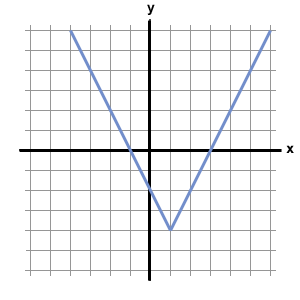All PSAT Math Resources
Example Questions
Example Question #121 : Coordinate Geometry

What is the equation of the line in the graph above?
In order to find the equation of a line in slope-intercept form 




Slope is the rate of change of a line, which can be calculated by figuring out the change in y divided by the change in x, using the formula

When looking at a graph, you can pick two points on a graph and substitute their x- and y-values into that equation. On this graph, it's easier to choose points like 

Plugging in those values for 

Example Question #1 : How To Graph A Line
What are the x- and y- intercepts of the equation 
Answer: (1/2,0) and (0,-2)
Finding the y-intercept: The y-intercept is the point at which the line crosses tye y-axis, meaning that x = 0 and the format of the ordered pair is (0,y) with y being the y-intercept. The equation 

Finding the x-intercept: To find the x-intercept of the equation 
The x-interecept is therefore (1/2,0).
Example Question #123 : Coordinate Geometry
Which of the following could be the equation of the line shown in this graph?

The line in the diagram has a negative slope and a positive y-intercept. It has a negative slope because the line moves from the upper left to the lower right, and it has a positive y-intercept because the line intercepts the y-axis above zero.
The only answer choice with a negative slope and a positive y-intercept is
Example Question #4 : How To Graph An Ordered Pair
Which of the following coordinate pairs is farthest from the origin?
Using the distance formula, calculate the distance from each of these points to the origin, (0, 0). While each answer choice has coordinates that add up to seven, (-1, 8) is the coordinate pair that produces the largest distance, namely 
Example Question #1 : How To Graph A Point
A point at 
The point 


The resultant coordinate is 
Example Question #1 : How To Graph A Point

Give the coordinates of the point plotted in the above set of coordinate axes.
None of the other responses is correct.
The point can be reached from the origin by moving 2 units right then 6 units up. This makes the first coordinate 2 and the second coordinate 6.
Example Question #3 : How To Graph A Function
Which of the following could be a value of 

The graph is a down-opening parabola with a maximum of 
Example Question #2 : Graphing
The figure above shows the graph of y = f(x). Which of the following is the graph of y = |f(x)|?
One of the properties of taking an absolute value of a function is that the values are all made positive. The values themselves do not change; only their signs do. In this graph, none of the y-values are negative, so none of them would change. Thus the two graphs should be identical.
Example Question #11 : Graphing
Below is the graph of the function 

Which of the following could be the equation for 
First, because the graph consists of pieces that are straight lines, the function must include an absolute value, whose functions usually have a distinctive "V" shape. Thus, we can eliminate f(x) = x2 – 4x + 3 from our choices. Furthermore, functions with x2 terms are curved parabolas, and do not have straight line segments. This means that f(x) = |x2 – 4x| – 3 is not the correct choice.
Next, let's examine f(x) = |2x – 6|. Because this function consists of an abolute value by itself, its graph will not have any negative values. An absolute value by itself will only yield non-negative numbers. Therefore, because the graph dips below the x-axis (which means f(x) has negative values), f(x) = |2x – 6| cannot be the correct answer.
Next, we can analyze f(x) = |x – 1| – 2. Let's allow x to equal 1 and see what value we would obtain from f(1).
f(1) = | 1 – 1 | – 2 = 0 – 2 = –2
However, the graph above shows that f(1) = –4. As a result, f(x) = |x – 1| – 2 cannot be the correct equation for the function.
By process of elimination, the answer must be f(x) = |2x – 2| – 4. We can verify this by plugging in several values of x into this equation. For example f(1) = |2 – 2| – 4 = –4, which corresponds to the point (1, –4) on the graph above. Likewise, if we plug 3 or –1 into the equation f(x) = |2x – 2| – 4, we obtain zero, meaning that the graph should cross the x-axis at 3 and –1. According to the graph above, this is exactly what happens.
The answer is f(x) = |2x – 2| – 4.
Example Question #4 : How To Graph A Function

What is the equation for the line pictured above?
A line has the equation




The 


The slope can be found by selecting two points, for example, the y-intercept and the next point over that crosses an even point, for example, 
Now applying the slope formula,
which yields 
Therefore the equation of the line becomes:
All PSAT Math Resources




























































